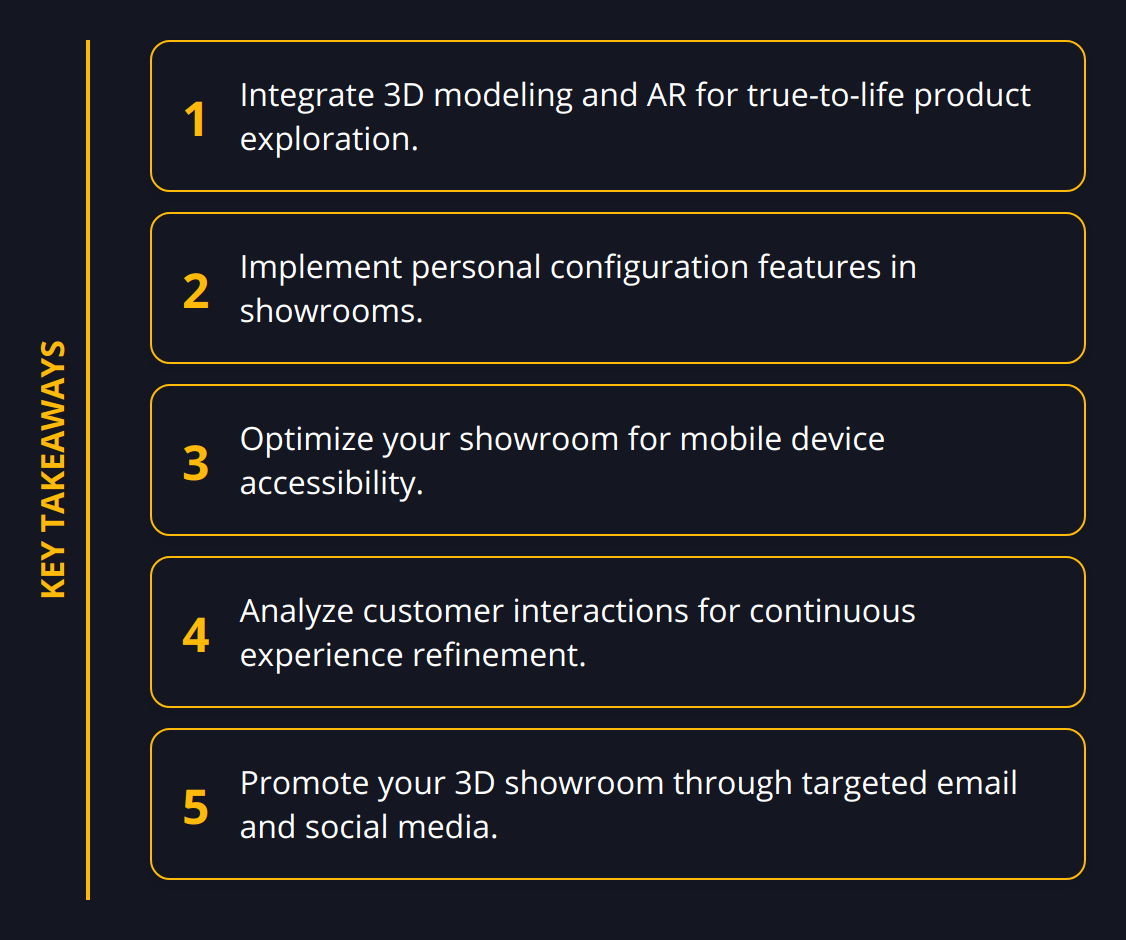Interactive 3D showrooms are redefining the traditional retail landscape, offering a dynamic and immersive way for customers to engage with products. We at Newroom Connect believe these virtual spaces harness the power of 3D and augmented reality technology to create an unparalleled shopping experience.
For businesses, this innovation is not just about staying ahead of the curve—it’s about connecting with consumers on an entirely new level. Both enterprises and shoppers stand to benefit from the convenience, interactivity, and enhanced decision-making these platforms provide.
Interactive 3D Tech in Retail
Interactive 3D showrooms have taken the digital retail space by storm, heralding a new wave of consumer engagement that marries technology with convenience. Understanding the architecture behind these innovative digital spaces is imperative for any brand looking to implement them effectively.
Central to interactive 3D showroom technology is the seamless integration of 3D modeling and augmented reality (AR). These technologies bring products to life, allowing customers to explore and interact with items in a hyper-realistic virtual environment. Interactive features like zoom, rotate, and color changing options provide an in-depth look at the product, much like an in-store experience, but with the added advantage of accessibility from anywhere at any time. We’ve moved past static images; now, a product can be viewed in granular detail, creating confidence in a buyer’s journey and driving conversion rates significantly. For instance, businesses that integrate 3D applications into their websites see up to a 40% increase in conversions compared to traditional methods.
In the realm of AR, the change is palpably transformative. With nearly 80% of consumers feeling more positive about purchases when AR is utilized, the ability to visualize an item in one’s personal space before buying is no mere novelty—it’s the new expectation. AR isn’t a standalone feature; when coupled with 3D, it creates an immersive tapestry that enhances the overall shopping experience, raising conversion rates by as much as 94%.
Key features within interactive 3D showrooms are numerous and ever-evolving. Users can virtually try on apparel, place furniture in their living room through their device’s camera, or tinker with the features of a car in granular detail. These customizations aren’t gimmicks; they’re practical tools cutting down on returns, hence saving businesses considerable operational costs.

Actionable insights for brands considering a foray into interactive 3D showrooms include:
-
Embrace 3D modeling and AR to offer customers a true-to-life product examination.
-
Incorporate features that allow personal configurations, simulating real-world product interaction.
-
Invest in technology that can optimize mobile experiences, as many users will access your showroom via smartphones and tablets.
-
Use analytics to understand customer interactions within the showroom and continuously refine the experience.
A solid example of this innovation at work is the fashion industry, where brands leverage 3D showrooms to deliver a comprehensive view of their collections without the physical inventory—a tremendous cost-cutting move.
In summary, this technology is a game-changer for retail businesses. It’s more than just a flashy showcase; it’s about giving customers a sense of ownership before the purchase, which in turn builds trust and loyalty towards your brand.

The next wave of retail innovation is here, and it’s vividly three-dimensional. The opportunity for brands to distance themselves from competitors through interactive 3D showrooms is clear, with evidence pointing to both improved customer satisfaction and tangible business results.
How Do Interactive 3D Showrooms Boost Business?
The retail industry is undergoing a seismic shift with the advent of interactive 3D showrooms. These innovative environments are not just flashy tech additions; they offer concrete benefits that align with core business goals. Engaging customers, increasing sales, and optimizing operational efficiency are paramount for any brand, and interactive 3D showrooms are the ideal vehicle to drive these metrics forward.
Elevating Customer Interactivity
Gone are the days when passive browsing was the norm in online shopping. Today’s consumers demand active participation. Interactive 3D showrooms meet this demand head-on, offering an environment where users can engage with products much like they would in a physical store. They can rotate items, change colors, and even test functions all in real-time. It’s this level of interactivity that helps foster a deeper connection with your offerings, leading to higher engagement levels. This enhanced interaction is not just about novelty; it heightens the shopping experience in a very practical way.
-
Customers spend more time on site due to engaging 3D visuals
-
Product pages with 3D views have lower bounce rates
-
Shoppers can customize products to their liking, increasing emotional investment

Revving Up Conversion Rates
It’s clear: interactive features directly correlate with improved conversion rates. Brands integrating 3D showrooms report a noticeable uptick in sales. Why? Because a customer who has thoroughly inspected and interacted with a product online is more likely to hit ‘purchase’. With clear evidence backing the influence of 3D and AR on shopping behavior, neglecting this technology is tantamount to leaving money on the table.
-
Interactive product demos double conversion likelihood
-
3D visualization can reduce cart abandonment
-
AR features enable shoppers to trial products in their own space, resulting in more confident buying decisions

Scaling Back on Costs
Reducing operational costs while maintaining or improving customer service quality might seem like a tall order, but interactive 3D showrooms rise to the occasion. Not only can you cut down on physical space and inventory needs, but you’re also likely to see a drop in product returns due to the precise visualizations and AR try-ons provided.
-
Virtual inventory showcase slashes physical sample production expenses
-
Detailed product interactions lower return rates due to unmatched buyer expectations
-
24/7 showroom availability cuts overhead costs linked to staffing and physical space maintenance
Boosting Overall Efficiency
Adopting an interactive 3D showroom translates into a sleek, efficient operation. Digital showrooms are relatively quick to set up and update compared to their physical counterparts. New products can be added with ease, promotions can be swiftly integrated, and the entire product range can be showcased without worrying about physical space limitations.
-
Quick product updates and changes save on logistical headaches
-
Streamlined buying process, from discovery to purchase
-
Data insights from user interactions inform stock and design choices
By tapping into the potential of interactive 3D showrooms, brands can craft a future-proof retail strategy that embraces the transition from physical to digital in a way that’s productive and profit-driving. It’s a strategic imperative in an increasingly digital-first consumer world.
For a more in-depth look at emerging retail technologies, exploring best practices for virtual trade fairs might offer further actionable insights.
How Do Interactive 3D Showrooms Benefit Customers?
Interactive 3D showrooms offer transformative benefits to customers, reshaping their shopping experience from the ground up. Imagine being able to perceptively assess a product, explore every detail up close, and make better-informed decisions without the constraints of store hours or location. This is not a vision of the distant future; it’s a practical enhancement to online shopping that’s available now.
A Tailored and Engaging Shopping Encounter
The draw of interactive 3D showrooms lies in their capacity for customization. Customers are no longer satisfied with browsing flat images; they yearn for a visceral understanding of what they’re purchasing. A dynamic 3D interface caters to this need by providing a virtual touch-and-feel experience akin to the physical store visit, complete with a 360-degree product evaluation. It’s this depth of immersion that makes the heart of the retail experience beat stronger online.

Bolstered Purchasing Confidence
The added layer of interaction with augments like AR technology means customers can virtually place products into their real-life environment, witnessing firsthand how a new sofa fits into their living room or how a watch looks on their wrist. The ability to personalize purchase decisions in this manner significantly minimizes uncertainty and, by extension, returns due to dissatisfaction.
Shopping Without Borders
Given the global reach of the internet, geographical constraints have lessened, yet the interactive 3D showroom takes this a step further, offering unparalleled accessibility. Whether from a busy subway commute or the comfort of a living room, these virtual spaces are available around the clock, removing the traditional limitations of time and place from the shopping equation. This level of convenience is more than an expectation; it’s becoming an integral part of the modern consumer’s lifestyle.
To illustrate the efficacy of 3D visual displays, consider car retailers utilizing interactive showrooms that allow customers to explore vehicle interiors in high definition, customize paint colors, and even simulate the driving experience. These features are not merely impressive; they are functional, empowering decisions that have tangible impacts on customer satisfaction.
Practical Advice for Navigating Interactive 3D Showrooms:
-
Familiarize yourself with the navigation tools to maximize product interaction.
-
Use the try-before-you-buy AR features to see how a product fits in your personal space.
-
Take advantage of the 24/7 availability to shop at your own convenience and pace.
By offering an innovative pathway to explore products online, interactive 3D showrooms are reshaping how we perceive online shopping. As we continue to witness the rise of virtual fairs, expect the retail landscape to keep evolving in exciting ways, with 3D showrooms leading the charge.
How to Launch Your Interactive 3D Showroom
Embarking on the exciting journey of launching an interactive 3D showroom can be transformative for your brand. With meticulous planning and execution, you will craft an experience that not only captivates customers but also sets your brand apart.
Crucial Steps to Establish Your Virtual Presence
Building your brand’s virtual showroom is a methodical process that calls for a blend of creativity and technical know-how. Start by conceptualizing the virtual space. Envision how your products will be displayed and how customers will interact with them. This initial blueprint is vital, giving structure to your creative aspirations.
Next, digitize your product catalog with high-quality 3D models. Each item should look as close to its physical counterpart as possible. This detail-oriented approach is proven to stimulate customer interaction, setting the stage for higher engagement.
Technology Integration and Optimization
Selecting the right software and technology for your interactive 3D showroom is critical. You would need a platform that’s robust, flexible, and capable of delivering a rich, interactive user experience. It must also integrate smoothly with your existing e-commerce ecosystem.
Optimization for various devices is non-negotiable. Considering that users will access your showroom across a myriad of devices, the experience must remain seamless and consistently interactive, whether on a desktop or a mobile device.
Marketing Your Interactive 3D Experience
Promoting your interactive 3D showroom involves a mix of traditional and innovative marketing strategies. Consider these action points to build momentum:
-
Announce your interactive 3D showroom launch through targeted email campaigns.
-
Utilize social media to showcase engaging previews of your virtual space.
-
Leverage search engine marketing to capture the interest of those searching for an immersive online shopping experience.
Turn Insights Into Action
The real power of your interactive 3D showroom lies in its capacity to generate insights into customer preferences. Track interactions, gather data, and use these learnings to refine user experience continuously. Remember, an agile approach to enhancements based on real data can significantly propel your brand forward.
Practical Use Strategies
Once your 3D showroom is operational, encourage customers to:
-
Bookmark your showroom for easy return visits
-
Share their configurations on social media for feedback and fun
-
Subscribe for updates on new product additions or features
To comprehend the depth of potential these virtual spaces offer, brands should explore informative insights like those found in the guide on virtual exhibition benefits.
Capitalizing on 3D Showroom Advantages
The benefits of implementing an interactive 3D showroom go well beyond cool factor or market buzz. It’s an investment that prepares your brand for the future, improves the bottom line, and reshapes customer experience in profound ways. By following these steps, your brand will not just adapt but thrive in the digital retail revolution.
Final Thoughts
The retail horizon is both expanding and transforming, morphing into an ecosystem where interactive 3D showrooms are rapidly becoming key players. This shift is driven by the palpable benefits they offer to both businesses and consumers. As a leader in creating virtual spaces, we at Newroom Connect consider it essential for brands to embrace this cutting-edge approach, blending innovation with practicality to elevate the shopping experience.

Interactive 3D Showrooms: A New Retail Standard
Interactive 3D showrooms are not just fleeting trends but an emerging standard in the retail industry. They represent a profound shift in how customers interact with products and make purchasing decisions, offering a digital enhancement to the tactile experience of traditional shopping.
-
They provide a compelling user experience
-
They put detailed product exploration at the consumer’s fingertips
-
They are shaping consumer expectations for online shopping
Benefits for Businesses and Consumers
Businesses adopting 3D showrooms notice a significant impact on their sales and operational efficiency, while customers enjoy an enriched, confident, and convenient shopping journey.
-
Businesses see increased engagement and sales conversion
-
Consumers enjoy a heightened sense of confidence in their purchases
-
Both parties benefit from the convenience and accessibility of virtual shopping
A Bold Move Forward
For brands that have not yet embraced this technology, the time to act is now. Adopting an interactive 3D showroom is not just about keeping pace; it’s about future-proofing your business and delivering value that resonates with the modern consumer.
-
Establish a competitive edge in the market
-
Foster a forward-thinking brand image
-
Engage with customers on a deeper level
At Newroom Connect, we provide the tools and expertise needed to create virtual trade fairs, virtual showrooms, or e-learning platforms tailored to your brand. Embracing these opportunities is not just a strategy but a pivotal movement towards an adaptive, immersive, and successful retail future. Join us on this transformative journey and reinvent the way the world shops.


